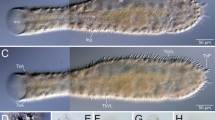Summary
The rectal papillae ofThrips consist of four types of cells arranged as a closed hollow pad. The inner layer is composed of five large primary cells (“Hauptzellen”) and of a drain cell (“Kanalzelle”). The primary cells contain glycogen in form ofβ-granula, and multivesicular bodies. Their apical cell membrane, forming numerous leaflets is associated with mitochondria and with a coat of repeating subunits on the cytoplasmic surface. The lateral plasma membrane of the primary cells has a sinuous course and is in close contact with numerous mitochondria. The intercellular spaces of the primary cell complex are drained to the central cavity of the papilla by a discharge formed by a curved elephant's trunk-like process of the drain cell. The outer layer of the papilla consists of an inner and an outer secondary cell (“Nebenzellen”). Their differentiations related to fluid transport are evident, but generally less elaborate. An open communication of the lumen of the papilla with the haemocoel was not detected. The papilla is connected with the rest of the rectal epithelium by junctional cells (“Verbindungszellen”). Neurosecretory terminals are present at the base of the papillae. The possible ways of fluid transport are discussed and the structure of theThrips papilla is compared with that in other insects.
Zusammenfassung
Die Rektalpapillen vonThrips bestehen aus vier Typen von Zellen, die eine polsterförmige Aufwölbung mit einem abgeschlossenen Hohlraum bilden. Die innere Zellschicht besteht aus fünf großen Hauptzellen und einer Kanalzelle. Die Hauptzellen enthalten Glykogen in Form vonβ-Granula und multivesikuläre Körper. Ihre apikale Zellmembran bildet einen Faltensaum mit einem regelmäßigen Partikelbesatz auf der Innenseite und angelagerten Mitochondrien. Die laterale Plasmamembran der Hauptzellen hat einen gewundenen Verlauf und steht in engem Kontakt zu zahlreichen Mitochondrien. Die Flüssigkeit in den Interzellularräumen des Hauptzellkomplexes wird über einen Kanal zum zentralen Hohlraum der Papille abgeleitet; er wird von einem gebogenen rüsselförmigen Fortsatz der Kanalzellen gebildet. Die äußere Schicht der Papille besteht aus einer inneren und einer äußeren Nebenzelle. Ihre Differenzierungen zum Flüssigkeitstransport sind deutlich, aber allgemein weniger hoch entwickelt. Eine offene Verbindung vom Lumen der Papille zum Haemocoel wurde nicht gefunden. Verbindungszellen bilden den Übergang von der Papille zum übrigen Rektalepithel. Axonendigungen mit Neurosekret liegen an der Papillenbasis. Die möglichen Wege des Flüssigkeitstransports werden diskutiert, und der Aufbau derThrips-Papillen wird mit dem bei anderen Insekten verglichen.
Similar content being viewed by others
Literatur
Bahadur, J.: Rectal pads in the Heteroptera. Proc. R. Ent. Soc. Lond. (A)38, 59–69 (1963)
Berridge, M.J., Gupta, B.L.: Fine-structural changes in relation to ion and water transport in the rectal papillae of the blowfly,Calliphora. J. Cell Sci.2, 89–112 (1967)
Berridge, M.J., Gupta, B.L.: Fine-structural localization of adenosine triphosphatase in the rectum ofCalliphora. J. Cell Sci.3, 17–32 (1968)
Berridge, M.J., Oschman, J.L.: Transporting Epithelia. New York-London: Academic Press 1972
Cheung, W.W.K., Marshall, A.T.: Water and ion regulation in cicadas in relation to xylem feeding. J. Ins. Physiol.19, 1801–1816 (1973a)
Cheung, W.W.K., Marshall, A.T.: Studies on water and ion transport in homopteran insects: Ultrastructure and cytochemistry of the cicadoid and cercopoid hindgut. Tiss. Cell5, 671–689 (1973b)
Davies, I., King, P.E.: The structure of the rectal papilla in a parasitoid HymenopteranNasonia vitripennis (Walker) (Hymenoptera Pteromalidae). Cell Tiss. Res.161, 413–419 (1975)
Goodchild, A.J.P.: The rectal glands ofHalosalada lateralis (Fallén) (Hemiptera — Saldidae) andHydrometra stagnorum L. (Hemiptera — Hydrometridae). Proc. R. Ent. Soc. Lond. (A)44, 62–70 (1969)
Gouranton, J.: Etude ultrastructurale du systeme cryptonephridien deCicadella viridis L. (Homoptera, Jassidae). C. r. hebd. Séanc. Acad. Sci. Paris D266, 1403–1406 (1968)
Gupta, B.L., Berridge, M.J.: A coat of repeating subunits on the cytoplasmic surface of the plasma membrane in the rectal papillae of the blowfly,Calliphora erythrocephala (Meig.), studied in situ by electron microscopy. J. Cell Biol.29, 376–382 (1966a)
Gupta, B.L., Berridge, M.J.: Fine structural organization of the rectum in the blowfly,Calliphora erythrocephala (Meig.) with special reference to connective tissue, tracheae and neurosecretory innervation in the rectal papillae. J. Morph.120, 23–82 (1966b)
Hennig, W.: Die Stammesgeschichte der Insekten. Frankfurt: Kramer 1969
Hopkins, C.R.: The fine structural changes observed in the rectal papillae of the mosquitoAedes aegypti, L. and their relation to the epithelial transport of water and inorganic ions. J. Roy. Micr. Soc.86, 235–252 (1966)
Jarial, M.S., Scudder, G.G.E.: The morphology and ultrastructure of the Malpighian tubules and hindgut inCenocorixa bifida (Hung.) (Hemiptera, Corixidae). Z. Morph. Ökol. Tiere68, 269–299 (1970)
Klocke, F.: Beiträge zur Anatomie und Histologie der Thysanopteren. Z. wiss. Zool. Abt. A128, 1–36 (1926)
Kümmel, G., Zerbst-Boroffka, I.: Elektronenmikroskopische und physiologische Untersuchungen an den Rectalpolstern vonApis mellifica. Cytobiol.9, 432–459 (1974)
Marinozzi, V.: The role of fixation in electron staining. J. Roy. Micr. Soc.81, 141–154 (1963)
Oschman, J.L., Wall, B.J.: The structure of the rectal pads ofPeriplaneta americana L. with regard to fluid transport. J. Morph.127, 475–510 (1969)
Perry, M.M.: Identification of glycogen in thin sections of amphibian embryos. J. Cell. Sci.2, 257–264 (1967)
Schumacher, W.: Physiologie in: Denffer, D. v., Schumacher, W., Mägdefrau, K., Ehrendorfer, F.: Lehrbuch der Botanik für Hochschulen, 30. Aufl. Stuttgart: Fischer 1971
Smith, D.S.: Insect cells. Their structure and function. Edinburgh: Oliver and Boyd 1968
Wall, B.J., Oschman, J.L.: Water and solute uptake by the rectal pads ofPeriplaneta americana L. J. Ins. Physiol.218, 1208–1215 (1970)
Wall, B.J., Oschman, J.L.: Structure and function of the rectal pads inBlattella andBlaberus with respect of the mechanism of water uptake. J. Morph.140, 105–118 (1973)
Wall, B.J., Oschman, J.L.: Structure and function of the rectum in insects. Fortschr. Zool.23, 193–222 (1975)
Wessing, A., Eichelberg, D.: Elektronenmikroskopische Untersuchungen zur Struktur und Funktion der Rektalpapillen vonDrosophila melanogaster. Z. Zellforsch.136, 415–432 (1973)
Author information
Authors and Affiliations
Rights and permissions
About this article
Cite this article
Bode, W. Die Ultrastruktur der Rektalpapillen vonThrips (Thysanoptera, Terebrantia). Zoomorphologie 86, 251–270 (1977). https://doi.org/10.1007/BF00993668
Received:
Issue Date:
DOI: https://doi.org/10.1007/BF00993668




